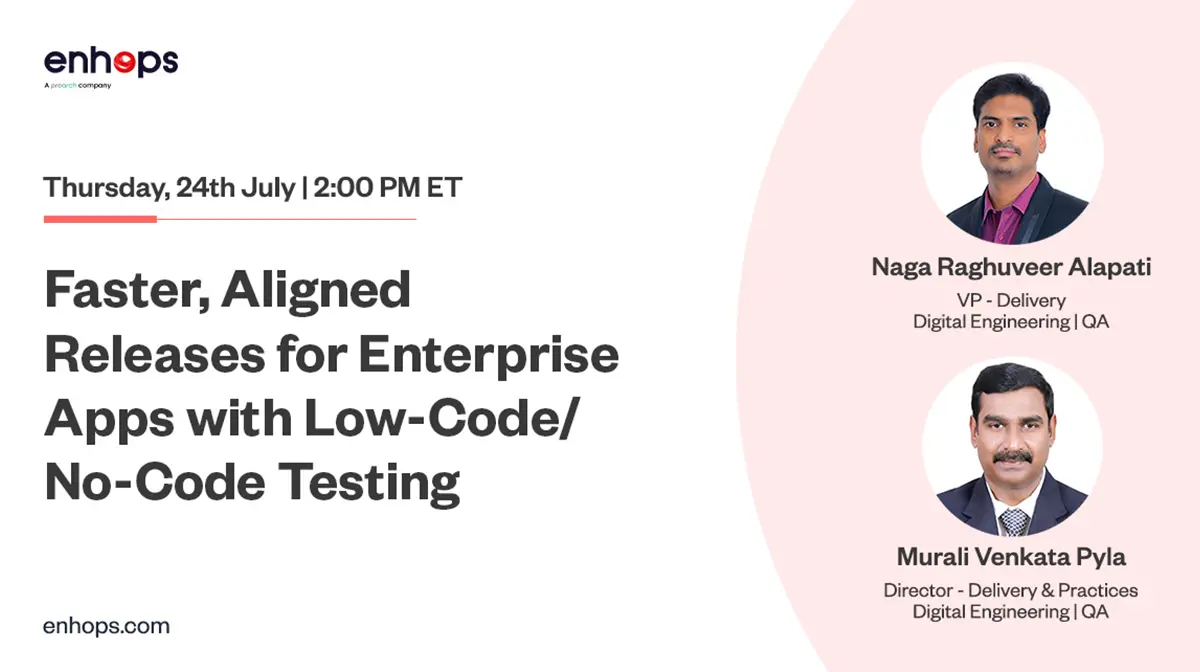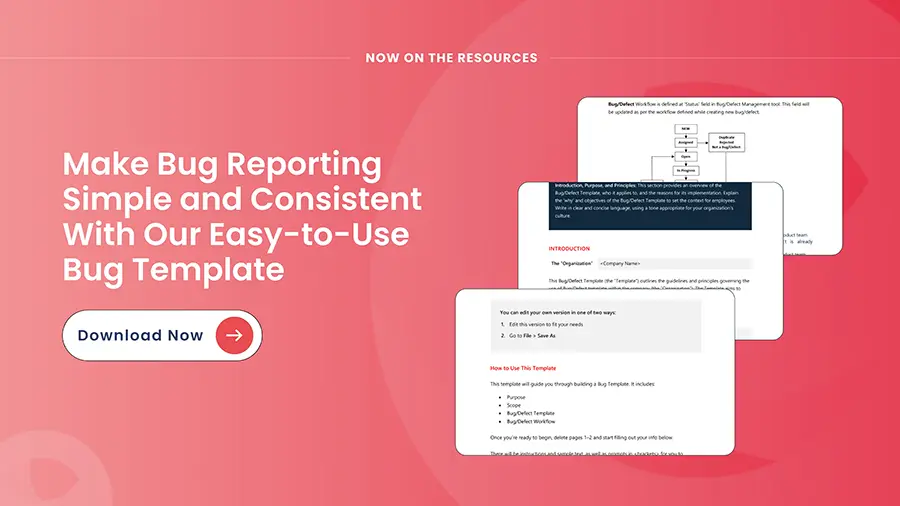Solving last-mile quality issues continues to be one of the biggest challenges for enterprise tech leaders. As organizations scale their digital initiatives, many are modernizing their test automation frameworks to improve test efficiency, accelerate releases, and strengthen product quality.
Choosing the right framework is crucial—it impacts scalability, maintenance, and collaboration across QA, development, and business teams. This guide will help you understand the major types of test automation frameworks, their benefits, team structures, and how to select the one that fits your organization’s goals.
Last mile quality issues mean slipping defects in the production and customers facing challenges while using applications. Every added inefficiency and bugs in the development process drives the cost of production and customer issues higher.
What Is a Test Automation Framework?
A test automation framework is a structured set of guidelines, tools, and best practices used to design, create, and execute automated tests. It defines how tests are organized, maintained, and integrated with CI/CD pipelines to ensure consistent quality across releases.
The right framework enables:
- Faster and reliable test execution
- Improved collaboration between teams
- Reduced manual efforts
- Greater scalability and reusability
Why Choosing the Right Framework Matters
Every inefficiency or defect that slips into production increases costs, customer dissatisfaction, and release delays. A suitable automation framework helps organizations:
- Detect defects early (shift-left testing)
- Support frequent releases and agile development
- Enable better reporting and analytics
- Improve ROI on test automation investments
Types of Test Automation Frameworks
Below are the most popular and effective frameworks used by enterprises today.
Linear Scripting Framework
Linear Scripting Framework is also known as the record and playback framework. Often it is referred as the most basic form of test automation. In this framework, testers write test cases in a linear sequence and then test cases are executed in a predefined order governed by user stories.
Best For:
Small applications with limited test cases, simple UI, and infrequent releases.
Key Benefits:
It is also suitable for organizations with limited automation skills and requiring quick turnaround with their test automation efforts. This framework is easy to implement and maintain.
Team Structure:
A small team of two manual testers and one test automation engineer can be sufficient to implement the linear scripting framework. The manual testers record and document test cases while test automation engineer can convert them into automated scripts. These scripts require continuous maintenance and updates as per changes in UI of the application.
Recommended For:
Organizations with limited technical resources and simple application with basic user interface and functionalities. We usually recommend linear scripting framework for applications with limited number of users and internal business operations.
Modular Framework
The Modular Test Automation framework breaks down a large application into small and independent components. These components are tested by developing their own set of tests. It makes it easy for testing teams to maintain and update tests as changes made to one module are irrespective of others.
We advise our clients to breakdown their application into modules and work with our automation experts to develop suitable automation framework for each of these modules. As the test automation framework for one module is implemented and tested successfully, they are integrated to test the entire application.
Best For:
Large, legacy or complex entireprise applications
Key Benefits:
- Scalability: Modular testing framework is highly scalable because these frameworks can be scaled as per the application requirements, adding of new modules and integration of additional features.
- Reusability: The best part of the modular testing framework is the reusability of these frameworks with variation in test data saving lot of time and effort.
- Maintainability: It is easier to maintain and update test automation frameworks in the modular automation framework.
Team Structure:
Modular Testing Framework requires a highly specialized and dedicated team with automation skills and ability to understand the application functionalities. A modular testing team should comprise of below engineers and architects –
Test Automation Architect designs and implements the modular testing framework. Test Automation architects have a deep understanding of application’s architecture, the tools and technologies, integration with existing CI-CD pipelines, and can design the individual frameworks to test each module or component independently. These architects further work with business stakeholders to understand business vision to scale automation frameworks.
Test Automation Engineers are responsible for developing, maintaining, updating test suite and test cases. They carry expertise in various test automation tools and programming languages. Test Automation engineers also provide consulting and advisory services in terms of adoption of new testing tools.
Functional Testers validates the functionality of the application and works closely with architects and automation engineers to develop and execute test cases.
Test Managers take care of test automation planning, execution, and reporting. They work closely with business stakeholders and architects to ensure that automation engineers are working towards achieving the organization’s goals.
Looking to expand your software testing team?
We can help
When to use Modular Testing Framework?
Modular testing framework works well for large and complex applications where teams also require scalability to cater to rising business needs. Some of the situations where a modular testing framework is appropriate are:
- Large and complex applications: Applications that have multiple functionalities and features are ideal for modular testing frameworks.
- Frequent Changes: Modular testing frameworks suit applications with frequent releases where there is constant requirement to update and maintain tests easily.
- Agile Development: Modular framework fits well in agile development practices because of the flexibility it provides in testing new modules and can be integrated within the development lifecycle.
- Cross-Functional Testing: This framework also helps in testing applications with multiple systems or platforms to test each module or component independently. This gives confidence before releases to make sure that the application functionalities are running as expected.
Data-Driven Framework
A Data-Driven Testing Framework separates test data from test scripts and test scripts use external data sources to run the test automation suite. External data sources can be Microsoft excel sheets, CSV files, or databases allowing scripts to run with multiple sets of data.
In such frameworks, test scripts are designed to accept static or dynamic data sets from an external source. Once the script runs, the output is logged into a report or file for reporting and analysis.
Best For:
Applications with large data volumes and frequent data variations.
Key Benefits:
- Reusability: These frameworks can be executed by different data sets and thus test scripts can be highly usable.
- Scalability: Data driven frameworks can handle large volumes of test data making it suitable for testing data-heavy and complex applications.
- Maintenance: It’s easy to maintain and generate external test data and execute test scripts without the need of modifying them.
- Coverage: Data driven frameworks offer better test coverage by testing multiple scenarios with different data sets.
- Consistency: With same test scripts run across various modules, teams can ensure consistency in rest results.
Team Structure:
Just like any other testing team structure, a data-driven testing team requires test automation architects, test automation engineers with special capabilities in data-driven testing and working with data-heavy applications, test managers to coordinate between business stakeholders and technical teams.
Data specialists are an added role in data driven testing framework. Because of the nature of the framework, data specialists are required to understand various data sources, their limitations, integration capabilities, cleaning and preparing data. With the advent of advanced AI-ML capabilities, we see role of data specialists is going to be outsourced to automation.
When to use Data driven framework?
Data driven frameworks provide efficient approach to ensure better automation coverage, easy maintainability, and scalability for data-heavy applications. Some of the scenarios where data driven frameworks work well are –
- Large and complex data sets: For applications with large and complex data sets, data-driven frameworks help in testing data sets independently.
- Multiple test scenarios: With data driven framework, it’s easy to test multiple scenarios with different data sets and ensure consistency and full coverage.
- Regression Testing: Data driven framework goes well with applications with frequent changes and helps in ensuring that tests are maintained and updated easily.
- Cross-functional testing: Applications that involve multiple systems or platforms and especially B2C applications are perfect candidate for data-driven testing.
Keyword Driven Framework
In keyword driven framework, test actions are defined using keywords to represent operations that are performed during test automation. This framework separates test logic from the automation logic, making it easier to write and maintain test scripts. This framework gives more opportunity for non-technical stakeholders to participate in testing.
While defining test cases, each test case consists of a series of actions defined using keywords, making it easy for non-technical stakeholders to maintain and update test scripts.
Best For:
Applications with complex business logic and frequent updates.
Key Benefits:
- Easy maintenance and modification of test scripts.
- Reusability of the code and data eliminating a lot of manual efforts and time.
- Improved collaboration between testers, developers, and business users as test logic is separated from the automation logic.
- More focus on user-based testing defined using user actions and keywords.
Team Structure:
Overall team structure for keyword driven test automation is similar to any other test automation team. However, keyword driven testing team should have involvement of business users like product owners, subject matter experts, functional consultants, and customer service teams.
Apart from this, the team comprises of test automation architect, test manager, test lead, test analysts and automation engineer. Test automation teams must have strong programming and automation tools knowledge to implement frameworks and best practices. Test automation teams must follow agile mindset to accommodate changing requirements within the business landscape.
When to use Keyword Driven Framework
Keyword driven framework is best suited for applications with complex business logic, multiple test cases and scenarios, and frequent releases. Some of the applications where keyword driven framework works well are –
- B2C and D2C applications: These applications come with multiple and complex business logic. Hence it is recommended to involve business stakeholders and use keyword based testing to separate test logic from automation logic.
- Business process-driven applications: Business process applications like human management portal, ERP systems, lab management systems, patient record systems, and more are ideal candidate for keyword driven framework. These systems are constantly used by non-technical end users hence it’s a good idea to implement keyword test automation framework.
- Limited programming skills: Teams with limited technical and programming skills must opt for keyword driven test automation framework for faster turnaround and efficient execution.
- Collaborative Testing: This framework promotes collaboration between testers, developers, and business stakeholders. As the test logics are written in natural keyword format, it is easier for everyone to collaborate and maintain test scripts.
Behavior Driven Development (BDD)
Behavior Driven Development frameworks is highly successful testing cum development methodology. It emphasizes in collaboration and communication among stakeholders. BDD brings developers, testers, and business analysts under one roof to automate testing based on the expected behavior of the software, rather than just its functional requirements. It involves using a language called “Gherkin” that is used to describe the expected behavior of the software in the natural form.
Read more about how BDD and Test Automation can change your testing function.
Best For:
Applications requiring strong alignment between business logic and user expectations.
Some of the key advantages of Behavior Driven Development are –
- Collaboration and Communication: BDD fosters collaboration and communication among technical and non-technical stakeholders ensuring that everyone understands testing nuances and contributes in meaningful ways.
- Focus on Behavior: BDD focuses on aligning test automation scripts as per user behavior and interaction patterns with the application.
- Reusability: BDD tests are easier to maintain and update as per the changing application as it is written in natural language format.
- Automation: BDD involves using automation tools that ensure consistency and increased efficiency.
Team Structure:
Behavior Driven Development requires cross-functional collaboration hence the team usually comprises of developers, testers, business analysts, product owners, and even technical leaders. The intention of having members from all functional areas is to understand application behavior and develop tests accordingly.
Further, the team should have proficiency in Gherkin language and automation tools and how to integrate BDD in the development lifecycle and agile methodology.
When to use Behavior Driven Development (BDD) Framework
In simple words, any application that requires close collaboration among stakeholders and have complex business workflows go well with BDD. Also, applications with high volume and high load of data and users can employ BDD to provide superior customer experience.
Several examples include eCommerce website, financial applications with strict compliance and regulations, healthcare applications with patient information and health records, supply chain management, gaming applications ERP and CRM systems, and mobile applications.
Test Driven Development
In test driven development (TDD), automated tests are written before development. The code written is expected to pass automated tests for achieving better code quality, improved design, and faster feedback cycles.
Best For:
Organizations seeking superior code quality and shorter development cycles.
Some of the benefits of using TDD approach are:
- Improved code quality: In TDD, automated tests are written before the code development. These codes are meant to pass the automated tests leading to improved code quality.
- Faster development cycles: In TDD approach, testing is shifted entirely left and hence overall development gets faster. The feedback loops are complete and faster with quicker release of new features and updates.
- Better collaboration: TDD promotes collaboration between developers, testers, and other stakeholders. This fosters a culture of quality across the organization and leads to better outcomes for the project as a whole.
- Increased Confidence: TDD enables more confident releases because codes are meant to be passed the automated tests. Production codes are thoroughly tested leading to more trusted product.
Team Structure:
Overall TDD requires complete involvement from management and a balanced team with technical and non-technical skills. At Enhops, we have worked with many clients with limited automation skills and helped them in kickstarting their automation journeys.
A typical TDD team consists of developers, testers, business analysts, and product owners. TDD team members must be well-versed in TDD practices and principles with proficiency in test automation, CI-CD, DevOps and Agile testing with great communication skills.
When to use Test Driven Development Framework
Test Driven Development can be applied to any application irrespective of programming language and development style. At Enhops, we specialize in implementing TDD across various testing functions and establish TCoE to help teams learn and adopt testing best practices.
We recommend moving to TDD frameworks to organizations on their digital transformation and digital acceleration journeys.
Comparison of Test Automation Frameworks
| Framework Type | Best For | Skill Level | Scalability | Collaboration | Maintenance Effort |
|---|---|---|---|---|---|
| Linear | Small apps with few test cases | Beginner | Low | Low | Low |
| Modular | Large, complex apps | Intermediate | High | Medium | Medium |
| Data-Driven | Data-heavy systems | Advanced | High | Medium | Medium |
| Keyword-Driven | Business process applications | Low to Medium | Medium | High | Low |
| BDD | Enterprise apps with user focus | Medium | High | Very High | Medium |
| TDD | Agile development and coding quality | Advanced | High | High | Medium |
How to Choose the Right Test Automation Framework
When selecting a framework, consider:
- The complexity and scale of your application
- Your team’s technical expertise
- The frequency of releases and need for scalability
- Integration with existing CI/CD tools
- Business goals for automation ROI and time-to-market
FAQs on Test Automation Frameworks
1. What are the main types of test automation frameworks?
Linear, Modular, Data-Driven, Keyword-Driven, BDD, and TDD are the most common frameworks used in automation testing.
2. Which framework is easiest to start with?
The Linear or Keyword-Driven framework is ideal for beginners or small applications.
3. How do I choose the right test automation framework?
Assess your project’s complexity, team skillset, test coverage needs, and scalability goals.
4. What’s the difference between BDD and TDD?
BDD focuses on user behavior and collaboration; TDD focuses on writing tests before code to ensure quality.
5. Which framework is best for enterprise applications?
Modular, Data-Driven, or BDD frameworks typically suit large enterprise or data-intensive applications.
Partner with Enhops to Modernize Your Testing Function
Selecting and implementing the right test automation framework can be complex. Enhops helps global clients design, implement, and optimize QA and automation strategies through:
- Test automation managed services
- Framework implementation and optimization
- Team augmentation and QA CoE setup
- Test advisory and consulting
Our expertise lies in financial, retail, gaming, and enterprise applications to strengthen quality assurance and quality engineering practices to create a long-term and sustainable quality strategy. Learn more about our Quality Assurance services or reach out to us today.




